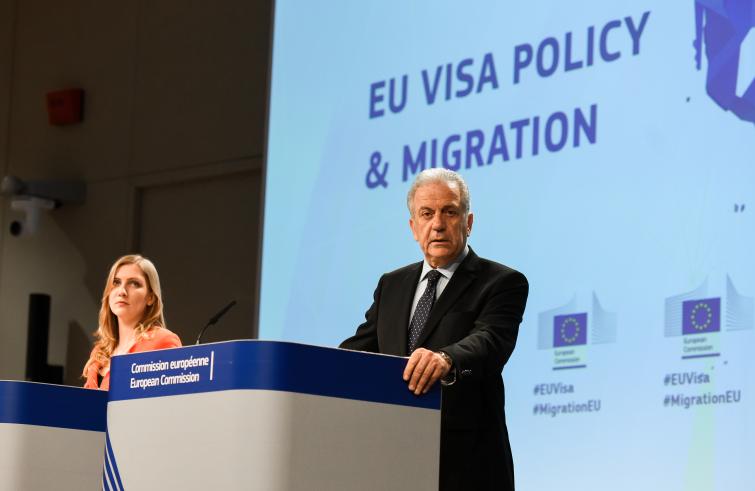
(from Brussels) Good intentions abound, but the proposals – and in some cases the commitments – generally fail to turn into action. Migratory pressure affecting the European shores of the Mediterranean for years, still exerting a heavy burden on Italy and Greece, topped the agenda of European Council meetings (EU-28 heads of government and State) countless times, as well as those of European parliament plenary sessions and EU Commission meetings. The latter in particular pushed for the creation of a “common migration policy”, in order to share responsibilities and commitments and release Rome and Athens from an unmanageable burden – humanitarian, economic and psychological, with undeniable impact on voters and political life. But little progress was made, coupled by explicit national closures and reiterated selfishness.
Europe also passes here. Ahead of the European Council of March 22-23, the Executive chaired by Jean-Claude Juncker resumed the agenda on migration by tabling a set of initiatives and projects during its March 14 meeting on “key actions” and legislative revisions – asylum included -. The governments of EU member Countries are now called to show whether the Community edifice still encompasses the principle of solidarity (the very principle invoked when eagerly withdrawing from structural funds), or if a more modest Europe à la carte prevails. From this perspective the Commission reported on “progress made under the European Agenda on Migration” and “and sets out further key actions to be taken.” Starting with the figures, once again astounding: “More than 285,000 migrants have been rescued by EU operations in the Mediterranean since February 2016 and in 2017 more than 2,000 migrants were saved in the desert after having been abandoned by smugglers.” And there’s more: “with 205 000 irregular border crossings in 2017, arrivals to the EU were 28% lower than in 2014, the year before the crisis.” Yet “pressure on national migration systems, while decreasing, remains at a high level with 685,000 asylum applications lodged in 2017.”
“A very fragile situation…”. The various operations initiated with the support of the EU, the UN and by many NGOs present in the Mediterranean and in migrants’ countries of origin and transit, “continue saving human lives.” But this is not enough. It is necessary “to tackle the root causes of this phenomenon, protect Europe’s external borders, and further strengthen cooperation with international partners.” For the Commission, the overall situation “remains fragile.” Thus “additional efforts, notably stepped up financial resources, will be needed jointly from the Member States and the EU to ensure a continued, effective response to the migration challenge.” The first Vice-President of the Commission, Frans Timmermans, called upon Member Countries not to withdraw, to “work hard, including finding agreement on the reformed asylum system.” High Representative/Vice-President Federica Mogherini said: “The strategy we have put in place to manage migration in partnership with key countries, UN organisations and the African Union is delivering. With the Joint AU–EU-UN Task Force, we assisted more than 15,000 people to return to their homes and start a new life, and we evacuated over 1.300 refugees from Libya. Cooperation and shared responsibilities are key to effectively address this global challenge.”
“No slowing down.” Also Dimitris Avramopoulos, Commissioner for Migration, is on the front line. He added: “With arrivals down by almost 30% compared to the pre-crisis year 2014, the time is ripe to speed up and intensify our efforts across the board – not to slow down. We cannot risk becoming complacent now. We need more and quicker actions on return, border management and legal channels, in particular resettlement from Africa but also Turkey.” On the same day was launched the mobilisation for the second tranche of the Facility for Refugees in Turkey (a total of 3€ billion in three years), which in the meantime is taking the burden of 3.5 million refugees from Syria, that must be given a roof over their heads, food, school education for children, medical treatment for the sick.
Where is the “Marshall Plan” for Africa? The documents drawn up by the Commission for the summit of EU28 leaders tackle almost all aspects of migration, without excluding the difficult relations with African Countries and Turkey itself, the concrete problems of rescues at sea and the management of refugee camps (often reminders of concentration camps) present in Libya and in other African Countries, the long-term development of the African Continent and of the Middle East – hunger and wars are the main causes of migration flows (that are bound to increase in the coming years, and that no “wall” can stop). For example, the EU Trust Fund for Africa “continues to play a critical role in addressing root causes” of migration, “providing protection to migrants and refugees along the route and fighting migrants smuggling and trafficking.” The Fund currently envisages 147 micro-programmes for a total of €2.5 billion approved across the Sahel and Lake Chad, the Horn of Africa and North Africa. However, “more than €1 billon is currently still lacking for the important work ahead.” It has been estimated – and officially declared – several times that a Marshall Plan” for Africa would require the immediate allocation of no less than €40 billion: a remarkably different figure compared to the scanty sums scraped together so far …
Various chapters. The “strategy” suggested by the Commission to EU leaders includes several more chapters: reinforcing external border management; delivering on return and readmission; resettlement scheme of refugees (it involved very low numbers so far, and far too many EU Countries reject it); Dublin and asylum policy reform. Without neglecting, for the future, legal migration channels, at least to provide the EU with young workforce and professions that have declined in the same European Countries. However, as mentioned, there is no shortage of projects and “paperwork”; what about the political will?










